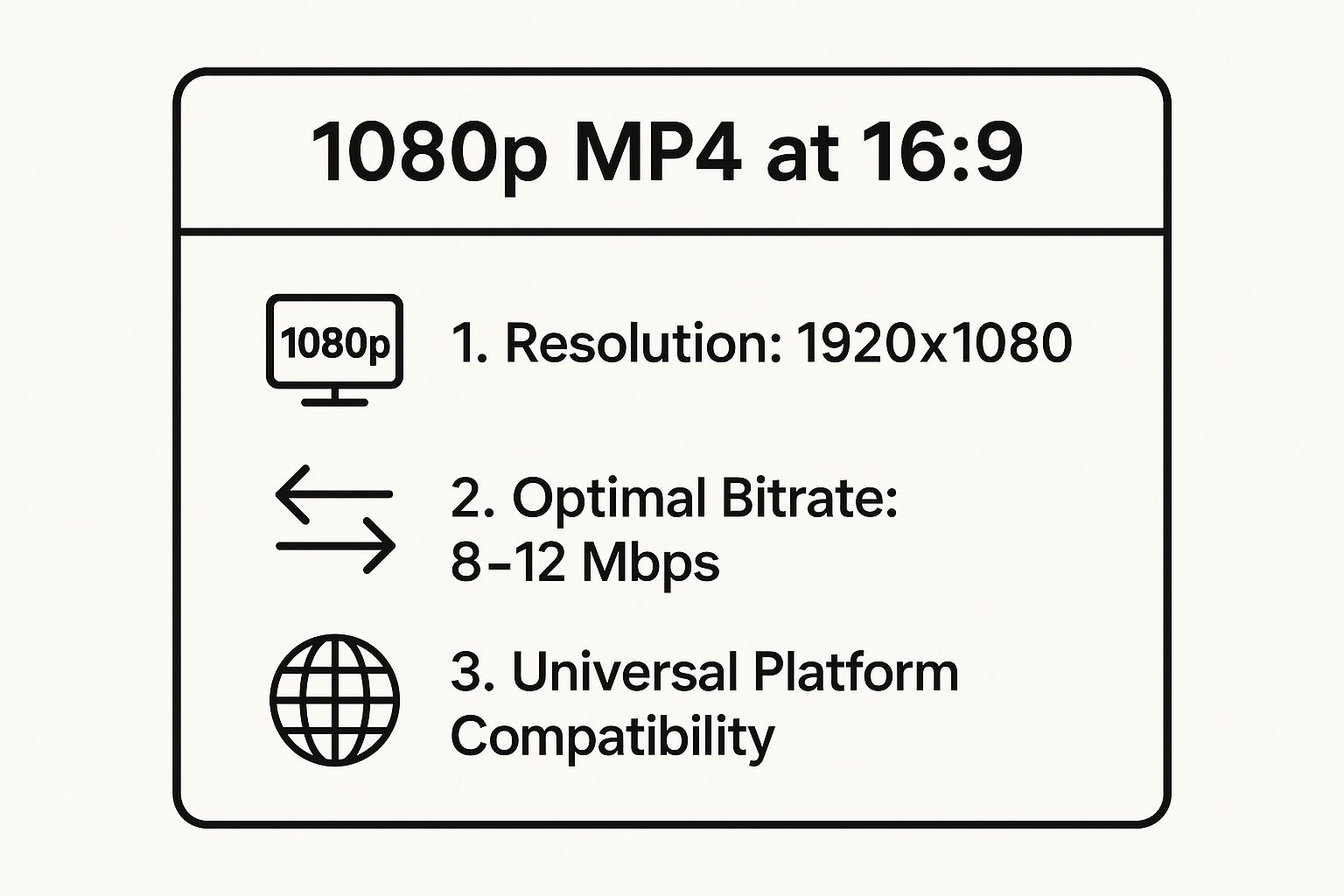Best Video Formats and Aspect Ratios for Maximum Engagement in 2025



In the crowded digital landscape, capturing audience attention is the ultimate currency. While compelling storytelling and high production value are crucial, an often-overlooked technical detail holds the key to unlocking peak performance: your choice of video format and aspect ratio. This isn't just a technical decision; it's a strategic one that directly impacts how your audience experiences and interacts with your content across different platforms.
The wrong choice can lead to awkward cropping, slow loading times, and a jarring viewing experience, causing viewers to scroll past without a second thought. The right combination, however, ensures your video is perfectly tailored for its intended platform, maximizing screen real estate, boosting algorithm favorability, and ultimately driving the engagement you need. Selecting the best video formats and aspect ratios for maximum engagement means your message is delivered exactly as you intended, whether on a desktop screen, a tablet, or a mobile phone.
Of course, the core quality of your recording sets the foundation for everything that follows. Creating polished audio-visual content often starts with the right production setup. If you're aiming to produce high-quality podcasts or video series, leveraging a professional podcasting studio environment can significantly elevate your final product before you even consider formatting.
This definitive guide breaks down the nine most effective format and aspect ratio combinations. We will provide a strategic blueprint to ensure your video content doesn't just get seen-it gets results. You will learn which specifications to use for platforms like YouTube, Instagram, TikTok, and LinkedIn, complete with actionable pros and cons to inform your content strategy immediately. Let's dive in.
1. 1080p MP4 at 16:9 Aspect Ratio: The Universal Standard for Quality
When searching for the best video formats and aspect ratios for maximum engagement, the 1080p MP4 in a 16:9 aspect ratio is the undisputed champion of versatility. This combination, featuring a Full HD resolution of 1920x1080 pixels, represents the gold standard for high-quality, horizontal video content. Its dominance stems from a perfect balance: it delivers crisp, professional-looking visuals without creating excessively large files that are difficult to store or stream.
The MP4 container (specifically using the H.264 codec) offers near-universal compatibility, ensuring your video plays flawlessly on almost any device, browser, or platform. From YouTube’s primary video player and Netflix’s standard streaming tier to corporate presentations and detailed educational courses, the 16:9 format is the native widescreen layout for most displays. This eliminates the distracting black bars that appear when a video's aspect ratio doesn't match the screen, providing a more immersive and engaging viewing experience.
When to Use This Format
This format is the go-to choice for evergreen, flagship content designed for desktop and television viewing. It's ideal for:
- YouTube: Perfect for long-form tutorials, product reviews, and brand storytelling.
- Corporate Video: The standard for professional training modules, webinar recordings, and official company announcements.
- Educational Content: Ensures clarity and detail for online courses and instructional videos.
This infographic provides a quick reference for the core specifications of the 1080p MP4 at 16:9 standard.

As the visualization highlights, sticking to these technical benchmarks ensures a high-quality output that is optimized for broad distribution. By mastering these fundamental settings, you can establish a strong foundation for your video strategy. For a deeper dive into production workflows, you can explore more best practices for video marketing to further refine your approach.
2. 1080p MP4 at 9:16 Vertical Aspect Ratio: The King of Mobile Engagement
As mobile devices become the primary screen for most users, the 1080p MP4 in a 9:16 aspect ratio has emerged as an essential component for any brand seeking maximum engagement. This vertical format, with a resolution of 1080x1920 pixels, is tailor-made for the smartphone viewing experience. It completely fills the screen, eliminating wasted space and creating a highly immersive, thumb-stopping visual that is critical for capturing attention in fast-scrolling social media feeds.

The 9:16 format's power lies in its native compatibility with platforms like TikTok, Instagram Reels, and YouTube Shorts. By designing content specifically for this portrait orientation, you respect the user's natural viewing habit and signal that your content is modern and platform-aware. The MP4 container with an H.264 codec remains the standard for its efficient compression and broad compatibility, ensuring your vertical videos load quickly and play smoothly on virtually any smartphone, which is crucial for retaining viewer interest.
When to Use This Format
This format is the undisputed champion for short-form, attention-grabbing content designed to go viral and drive immediate interaction on social media. It is perfect for:
- TikTok, Instagram Reels & YouTube Shorts: Ideal for trends, behind-the-scenes clips, and quick tutorials.
- Social Media Stories: The native format for ephemeral content on Instagram, Facebook, and Snapchat.
- Mobile-First Advertising: Essential for ad campaigns targeting users on their smartphones, ensuring maximum screen real estate.
The video below demonstrates how a simple concept can be transformed into engaging vertical content.
To get the most out of this format, it's vital to hook viewers within the first three seconds and keep key visuals centered. Large, easily readable text and graphics designed for a vertical canvas are non-negotiable. Mastering this aspect of the best video formats and aspect ratios is key to connecting with a mobile audience. For a more detailed guide on creating effective campaigns, you can explore strategies for mobile video advertising to elevate your approach.
3. 720p MP4 at 16:9 Aspect Ratio: The Efficiency Champion
While 1080p sets the quality standard, the 720p MP4 in a 16:9 aspect ratio emerges as the champion of efficiency and accessibility. This format, with its HD resolution of 1280x720 pixels, provides a critical balance between clear, professional-looking video and practical file management. It delivers a quality viewing experience while creating significantly smaller files, which translates to faster upload times, reduced storage costs, and smoother streaming for audiences with limited internet bandwidth.
The 720p resolution is a strategic choice when speed and accessibility are more important than cinematic detail. It still looks crisp and professional on most mobile devices and standard laptop screens, where the difference between 720p and 1080p is often negligible. Paired with the universally compatible MP4 container (H.264 codec), this format ensures your content reaches the widest possible audience without technical barriers, making it a cornerstone for certain types of video strategies.
When to Use This Format
This format is the workhorse for content where speed, stability, and broad reach are the primary goals. It is particularly effective for:
- Live Streaming: The smaller file size reduces buffering and maintains a more stable connection on platforms like YouTube Live and Twitch, which is crucial for real-time engagement.
- Internal Communications: Perfect for quick company updates, training videos, or announcements where rapid distribution is more important than ultra-high resolution.
- Quick Social Media Videos: Ideal for producing and uploading timely content on a rapid schedule without long rendering or upload delays.
- Global Audiences: An excellent choice for educational content or marketing materials intended for international viewers who may have slower or less reliable internet connections.
4. 1080p MP4 at 1:1 Square Aspect Ratio: The Social Media Feed Dominator
When it comes to the best video formats and aspect ratios for maximum engagement on social media, the 1:1 square video is an essential tool. This format, typically rendered as a 1080p MP4 with a 1080x1080 pixel resolution, was popularized by platforms like Instagram and remains a powerful choice for grabbing attention in crowded feeds. Its primary advantage is screen real estate; square videos take up significantly more vertical space on a mobile screen compared to horizontal 16:9 content, making them harder to scroll past.
This increased visibility directly translates to higher engagement rates on platforms where users are rapidly scanning content. The MP4 container, combined with the H.264 codec, ensures the video is optimized for smooth playback across all major social networks, including Facebook, LinkedIn, and X (formerly Twitter). The 1:1 format strikes a perfect balance, performing well on both mobile and desktop feeds without requiring users to rotate their phones, thus removing a key point of friction and keeping them engaged with the content.

When to Use This Format
The square format is tailor-made for short-form, attention-grabbing content designed for in-feed consumption. It is the ideal choice for:
- Social Media Ads: Perfect for paid campaigns on Facebook and Instagram, where maximizing screen space is crucial for stopping the scroll.
- Brand Storytelling: Use it for quick, impactful brand messages, behind-the-scenes clips, or employee spotlights on LinkedIn.
- Product Demos: Ideal for showcasing a product's features in a concise, visually engaging format that works seamlessly across multiple platforms.
Because this format is so visually driven, it is an excellent candidate for animated content. Using bold graphics and text is key to making square videos stand out, and animation can elevate this even further. You can explore how to leverage animated business videos to create dynamic and effective square content for your campaigns. By planning your composition specifically for the 1:1 frame and keeping key visual elements centered, you ensure your message is delivered effectively, no matter the device.
5. 4K MP4 at 16:9 Aspect Ratio: The Future-Proof Premium Standard
For brands aiming to establish a premium image and future-proof their flagship content, the 4K MP4 in a 16:9 aspect ratio is the ultimate choice. This format, boasting an Ultra High Definition (UHD) resolution of 3840x2160 pixels, delivers breathtaking detail and clarity that positions your content at the pinnacle of quality. It is the definitive option for creating visually stunning, cinematic experiences that capture and hold viewer attention.
The primary benefit of 4K is its exceptional level of detail, making it ideal for showcasing intricate products, capturing sweeping landscapes, or creating a high-end, professional feel. While the files are significantly larger than 1080p, the investment pays off in long-term relevance. As more viewers adopt 4K-capable screens, from televisions to computer monitors, content produced in this format will maintain its visual integrity for years to come. This makes it one of the best video formats and aspect ratios for maximum engagement with audiences who value superior quality.
When to Use This Format
This format should be reserved for your most important, evergreen content where visual excellence is paramount. It is the premier choice for:
- High-End Brand Campaigns: Create cinematic commercials and brand stories that reflect a commitment to quality.
- Luxury Product Showcases: Display the fine details and craftsmanship of premium products with unmatched clarity.
- Documentary Content: Capture rich, immersive visuals that draw the viewer into the narrative.
- Professional Training Materials: Provide crystal-clear demonstrations for complex technical or medical procedures.
When working with such high-resolution footage, a powerful editing process is crucial. Mastering a professional workflow ensures that the final output justifies the investment in 4K production. You can learn more about the specifics in this comprehensive guide to video editing to optimize your post-production. By adopting 4K, you are not just creating a video; you are making a long-term investment in your brand's visual identity.
6. 1080p MP4 at 21:9 Cinematic Aspect Ratio: The Storyteller's Widescreen
For brands aiming to evoke a premium, film-like quality, the 21:9 cinematic aspect ratio is a storytelling powerhouse. This ultra-wide format, often presented in a 2560x1080 resolution within a 1080p workflow, creates an immersive visual field that immediately distinguishes content from standard widescreen videos. It provides an expansive canvas, perfect for capturing breathtaking landscapes, dynamic action, and emotionally resonant scenes.
This format leverages the same highly compatible MP4 (H.264) container as other standards, ensuring smooth playback. However, its true power lies in perception. The wider frame is intrinsically linked with cinema, subconsciously signaling high production value and epic narratives to the viewer. This makes it an exceptional choice when your goal is not just to inform, but to captivate and create a memorable, artistic impression. Luxury automotive brands and high-end fashion companies frequently use this format to build a sense of prestige and aspiration.

When to Use This Format
Reserve this format for high-impact, flagship content where creating an emotional connection and a premium brand image is the primary objective. It is particularly effective for:
- Brand Story Documentaries: Tell your company's origin story or highlight its mission with cinematic flair.
- High-End Product Launches: Showcase a new luxury product with sweeping shots and dramatic reveals.
- Cinematic Advertisements: Create ad campaigns that feel more like short films than commercials.
- Travel and Lifestyle Videos: Capture the full scope and beauty of exotic locations and aspirational experiences.
When considering the best video formats and aspect ratios for maximum engagement, the 21:9 ratio is your tool for crafting an unforgettable viewing experience. To maximize its impact, focus on composition that utilizes the entire horizontal space, incorporating wide shots and smooth, panning camera movements. While it creates letterboxing (black bars) on standard 16:9 screens, this is often a desired effect that reinforces its cinematic feel. However, always consider the final viewing context, as the effect may be less ideal on vertical mobile displays.
7. 720p WebM at 16:9 Aspect Ratio: The Web-Optimized Speed Champion
When exploring the best video formats and aspect ratios for maximum engagement, the 720p WebM format in a 16:9 aspect ratio emerges as the premier choice for web-native performance. Developed specifically for the internet by Google, WebM offers superior compression compared to MP4, resulting in significantly smaller file sizes without a drastic loss in visual quality. This efficiency is critical for maintaining fast website load times, a key factor in both user experience and search engine optimization (SEO).
The WebM container, typically using the VP8 or VP9 video codec, is designed for HTML5 video playback. Its primary advantage is reducing page weight, which directly impacts how quickly your content becomes visible and interactive for visitors. For websites embedding background videos, product demonstrations, or blog content, this format ensures smooth playback without causing frustrating delays. A fast-loading video keeps users on the page longer, reducing bounce rates and signaling positive engagement metrics to search engines.
When to Use This Format
This format is the definitive solution for any video embedded directly into a website where performance is paramount. It is especially effective for:
- Website Background Videos: Creates an immersive, dynamic hero section without slowing down the site.
- E-learning Platform Content: Ensures quick loading of lesson videos for a seamless educational experience.
- Blog and News Content: Embeds supplementary video content within articles without harming page speed scores.
- Progressive Web Applications (PWAs): Provides a lightweight video solution for app-like experiences in a browser.
Key Tip: While WebM boasts excellent modern browser support, it's a best practice to provide an MP4 version as a fallback. This ensures universal compatibility for users on older browsers or systems like Safari, which have historically been slower to adopt the format. Using the HTML5 <video> tag with multiple <source> elements makes this easy to implement.
8. 1080p MP4 at 4:5 Aspect Ratio: The Mobile-First Engagement Sweet Spot
As social media consumption has shifted decisively to mobile devices, the 4:5 aspect ratio has emerged as a powerhouse for engagement. This vertical format, typically with a resolution of 1080x1350 pixels, is a critical tool in any discussion of the best video formats and aspect ratios for maximum engagement. It strikes an optimal balance: it’s taller than a square video, occupying more valuable screen real estate in a user's feed, but not so tall that it requires viewers to turn their phones or gets awkwardly cropped in platform previews.
This "portrait" orientation is perfectly suited for feed-based platforms like Instagram and Facebook. The additional vertical space allows creators to present subjects, like people or products, in a more natural, full-frame view without the constraints of a wider or square format. Using the universally compatible MP4 container with an H.264 codec ensures that these mobile-optimized videos load quickly and play smoothly, which is crucial for capturing the fleeting attention of scrolling users. The result is a more immersive and less disruptive viewing experience that feels native to the mobile environment.
When to Use This Format
The 4:5 aspect ratio is the premier choice for organic and paid content designed for mobile-first social media feeds. Its ability to command visual attention makes it ideal for:
- Instagram & Facebook Feeds: Perfect for in-feed video posts and mobile-optimized ads that aim to stop the scroll.
- Product Showcase Videos: Ideal for demonstrating portrait-oriented products, like fashion apparel or mobile apps.
- Influencer Marketing: A preferred format for influencer collaborations, as it naturally frames a person speaking to the camera.
Pro Tip: When shooting for a 4:5 delivery, frame your shots vertically from the start. While you can crop a 16:9 video, you will lose significant horizontal context. A native vertical composition ensures your subject remains the central focus without awkward cropping.
The rise of this format is directly tied to the success of short-form video content, which prioritizes vertical viewing. By adopting the 4:5 ratio, you align your content strategy with proven user behavior, increasing the likelihood of watches, likes, and shares. To better understand how this fits into a broader mobile strategy, you can find more information about the impact of short-form video like Reels and how to leverage it effectively.
9. 1080p MP4 at 2:3 Aspect Ratio: The Story-Optimized Format for Immersive Mobile Experiences
The 1080p MP4 at a 2:3 aspect ratio is purpose-built for full-screen stories and vertical video placements. At 1080x1620 pixels, this format delivers immersive, portrait-oriented content that fills the entire mobile viewport. It’s perfectly suited for short-form narratives and ephemeral campaigns that demand professional-grade quality while remaining quick to produce and share.
Leveraging the MP4 container with the H.264 codec offers broad device and platform support. This format streams smoothly over cellular networks and keeps file sizes manageable without sacrificing visual fidelity. Brands can maintain consistent color grading and sharp imagery across Instagram Stories, Snapchat, Facebook Stories, LinkedIn Stories, and other story-based platforms.
Key Insight: Prioritizing the 2:3 aspect ratio turns fleeting story views into actionable engagement and higher retention.
Adopting this vertical orientation can boost completion rates by up to 25 percent on story-driven channels. Its full-screen layout minimizes distractions and maximizes dwell time. Marketers report significantly improved swipe-up clicks and interaction metrics when every pixel is optimized for portrait viewing.
When to Use This Format
- Instagram Stories for product announcements and limited-time offers
- Facebook Stories to spotlight behind-the-scenes footage
- Snapchat content that relies on authentic, real-time storytelling
- LinkedIn Stories for thought leadership snippets and quick updates
- Any platform where vertical, full-screen engagement drives viewer action
Tips for Maximum Impact
- Keep key elements within the top and bottom safe zones
- Use large, bold text and high-contrast graphics for readability
- Craft hooks in the first 3 seconds to prevent swipe-aways
- Design natively for story consumption instead of repurposing horizontal cuts
- End with a clear call-to-action or interactive sticker to boost conversions
This 1080p MP4 at 2:3 format deserves its place in any engagement-driven strategy because it aligns with mobile user behavior and platform mechanics. For more tactical guidance on video storytelling, explore our best practices for mobile video marketing.
Video Format & Aspect Ratio Comparison
From Format to Impact: Implementing Your Video Strategy
Navigating the landscape of video production can feel like a complex puzzle of resolutions, containers, and orientations. As we've detailed, the optimal choice is rarely a single, universal answer. Instead, the path to powerful video lies in strategic alignment. Choosing the best video formats and aspect ratios for maximum engagement isn't just a technical decision; it's a creative one that directly influences how your audience receives and interacts with your message.
The core lesson from our exploration of formats like MP4 and WebM, and ratios from 16:9 cinematic to 9:16 vertical, is that context is king. A stunning 4K 16:9 masterpiece destined for a YouTube brand channel will fall flat if carelessly cropped for an Instagram Story. Similarly, a fast-paced, vertical 9:16 clip designed for TikTok’s ephemeral feed would feel jarring and unprofessional on a corporate LinkedIn page. The most successful content creators and marketers adopt a "platform-first" mindset, planning the final destination of their video from the earliest stages of ideation.
Key Takeaways for Immediate Implementation
To distill our findings into actionable steps, focus on these critical pillars of your video strategy:
- Audience-Centric Selection: Always begin with your audience. Where do they spend their time? How do they consume content on that platform? A mobile-first audience on Instagram or TikTok demands vertical (9:16) or near-vertical (4:5) content, while a desktop-heavy audience on YouTube or a company website expects a traditional widescreen (16:9) experience.
- Purpose-Driven Production: Define the goal of each video. Is it a high-impact brand awareness film? Use 4K MP4 at 16:9 for that premium, cinematic feel. Is it a quick, engaging social media ad? A 1080p MP4 at 1:1 or 4:5 offers maximum feed visibility and impact. Is it a website background video? A lightweight 720p WebM file ensures fast load times without sacrificing quality.
- Proactive "Shoot-to-Format" Approach: Avoid the post-production nightmare of "fixing it in post." By planning your aspect ratios before you ever hit record, you ensure your compositions are intentional. This means framing your shots with the final aspect ratio in mind, placing key subjects and graphics within safe zones that won't be awkwardly cropped later.
Strategic Insight: True video mastery is achieved when technical specifications and creative vision are perfectly synchronized. Your choice of format and aspect ratio should be a deliberate tool to enhance your narrative, not an afterthought.
Weaving Video into Your Broader Brand Identity
Ultimately, these technical choices must serve a larger purpose: building a cohesive and recognizable brand. The visual language you establish with your video content, from the color grade to the aspect ratio, should feel consistent across all touchpoints. To ensure your video content aligns seamlessly with your brand's presence across various platforms, it's essential to also consider comprehensive social media brand guidelines that dictate consistent voice and visuals. This holistic approach ensures that whether a customer sees your video on YouTube, TikTok, or your website, they instantly recognize it as yours.
Mastering these nuances transforms your video assets from simple media files into high-performance engines for connection and conversion. By respecting the platform, understanding your audience, and planning with intention, you ensure every pixel and every frame works tirelessly to capture attention and achieve your business objectives. This is how you move beyond just making videos and start creating real impact.
Feeling overwhelmed by the technical details of video production? Moonb integrates a full-stack creative team directly into your workflow, handling everything from strategic planning to motion design. Let us manage the complexities of formats and aspect ratios so you can focus on growing your business. Explore how Moonb can elevate your video strategy today.






